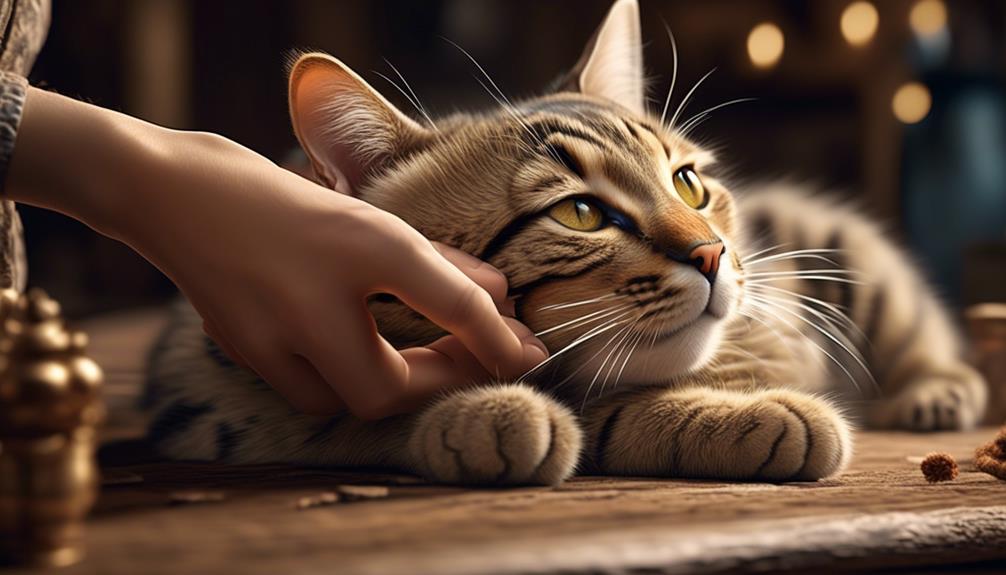Have you ever wondered if cats actually enjoy having their paws massaged? It’s a common theory that cats find comfort and relaxation in having their paws gently kneaded, but is there any truth to it?
Well, the answer may surprise you. While some cats do seem to appreciate the sensation of a paw massage, others may not be as receptive. But don’t worry, because in this discussion, we will explore the fascinating world of cats and paw massages, uncovering the benefits, alternative ways to show your cat affection, the importance of understanding individual preferences, and key considerations when giving paw massages.
So, whether you’re a curious cat owner or simply looking to enhance your feline friend’s well-being, stay tuned for an enlightening exploration into the world of cat paw massages.
Understanding Cats’ Paw Preferences
Understanding cats’ paw preferences is essential for fostering a strong bond with your feline companion. Cats, like humans, have individual preferences and personalities. Some cats may enjoy paw massages, while others may not. To determine if your cat likes paw massages, start by gently touching its feet. Observe its reaction – if your cat pulls its paws away, it probably doesn’t want you to touch them. However, if your cat remains calm and relaxed, it may enjoy the sensation. Gradually introduce gentle petting to help your cat get used to the feeling.
Giving your cat a paw massage has several benefits. It helps cats become more comfortable with having their feet handled, which is particularly useful during nail trimming. Desensitization through paw massages can reduce stress and anxiety for both you and your cat. Additionally, regular paw massages allow you to check for any health problems, such as cuts, scrapes, or split nails. By catching these injuries early, you can prevent them from becoming more painful or serious.
It’s important to remember that cats have unique likes, dislikes, and personalities. What one cat enjoys, another may dislike. Understanding your cat’s individual preferences is crucial for building a stronger bond. Respecting your cat’s boundaries fosters trust and comfort. Tailoring affection to your cat’s preferences ensures a positive experience.
When giving paw massages, take it slow and be patient with your cat. Observe its reactions to determine its comfort level. If your cat consistently shows signs of discomfort or dislikes paw massages, it may be best to seek professional advice. Lastly, it’s important to note that not all cats will enjoy or tolerate paw massages.
Benefits of Paw Massages for Cats
Paw massages offer a range of benefits for cats. Not only do they help cats become more comfortable with having their feet handled, but they also have several other advantages. Desensitization through paw massages can reduce stress and anxiety during nail trimming, making the process easier for both you and your cat. Additionally, regular paw massages allow you to check for health problems like cuts, scrapes, and split nails. By catching injuries early, you can prevent them from becoming more painful or serious. Moreover, paw massages help strengthen the bond between you and your cat, enhancing your relationship.
To help you better understand the benefits of paw massages for cats, here is a table summarizing them:
| Benefits of Paw Massages for Cats |
|---|
| Comfort with foot handling |
| Stress and anxiety reduction |
| Health problem detection |
| Injury prevention |
| Stronger bond with your cat |
Importance of Individuality in Cats

When considering the well-being of your cat, it’s crucial to recognize the significance of their individual preferences and personalities. Cats, like humans, have unique likes, dislikes, and behaviors. What one cat may enjoy, another may dislike entirely. Understanding your cat’s individuality is key to building a strong bond and fostering trust and comfort.
Respecting your cat’s boundaries and tailoring your affection to their preferences ensures a positive experience for both you and your feline companion. By observing your cat’s reactions and taking it slow, you can determine their comfort level when it comes to activities such as paw massages. It’s important to note that not all cats will enjoy or tolerate paw massages, and forcing them can cause discomfort or stress.
Ways to Show Affection to Your Cat

When it comes to showing affection to your cat, there are various ways to cater to their individual preferences.
Understanding your cat’s favorite petting spots, such as their tummy or behind their ears, can help you express affection in a way they enjoy.
Additionally, non-touch affection options like snuggling up together or offering treats can also strengthen the bond between you and your feline friend.
Favorite Petting Spots
One way to show affection to your cat is by petting them in their preferred spots. Cats have specific areas on their bodies that they enjoy being touched, and knowing these spots can strengthen your bond with your feline friend. Here are some favorite petting spots for cats:
| Preferred Spot | Description | Benefits |
|---|---|---|
| Chin | Gentle strokes under the chin | Releases scent glands and feels comforting |
| Behind the ears | Lightly scratch behind the ears | Provides a relaxing sensation |
| Base of the tail | Slowly stroke the base of the tail | Can induce a sense of calm |
| Cheeks | Gently rub the cheeks with your fingers | Mimics friendly feline behavior |
Non-Touch Affection Options
To show affection to your cat without touch, there are several non-tactile options that can help strengthen the bond between you and your feline companion.
Letting your cat snuggle up to you is a simple way to show love. Petting areas your cat enjoys, such as their tummy or behind their ears, can be affectionate. Grooming your cat by brushing them shows care and mimics motherly grooming. Offering treats, wet food, catnip, or snacks can create positive experiences. Any positive experience with your cat strengthens the bond you share.
Cats have unique likes, dislikes, and personalities. What one cat enjoys, another may dislike. Understanding your cat’s individual preferences helps build a stronger bond. Respecting your cat’s boundaries fosters trust and comfort. Tailoring affection to your cat’s preferences ensures a positive experience.
Considerations for Giving Paw Massages
Are you unsure about how to give your cat a paw massage? When it comes to giving your feline friend a paw massage, there are a few considerations to keep in mind. First, it’s important to understand that not all cats will enjoy or tolerate paw massages. Cats have individual preferences and personalities, so what may be pleasurable for one cat may not be for another.
To help guide you through the process, here are some considerations for giving paw massages:
| Considerations | Tips |
|---|---|
| Take it slow and be patient | Allow your cat to get comfortable with the idea of a paw massage. Start by gently touching its feet and gradually introduce gentle petting. |
| Observe your cat’s reactions | Watch for signs of discomfort or stress. If your cat pulls its paws away or shows signs of agitation, it may not want you to touch its paws. |
| Avoid forcing the massage | If your cat shows signs of discomfort or dislike, it’s important to respect its boundaries. Forcing a paw massage can lead to a negative experience. |
| Seek professional advice if necessary | If your cat consistently dislikes paw massages or shows signs of pain or discomfort, it’s best to consult with a veterinarian or animal behaviorist. |
| Respect your cat’s preferences | Every cat is unique, so tailoring affection to your cat’s preferences is crucial. Some cats may prefer other forms of affection over paw massages. |
Seeking Professional Advice for Discomfort
If your cat consistently dislikes paw massages or shows signs of pain or discomfort, it’s advisable to consult with a veterinarian or animal behaviorist for professional advice. Cats, like humans, can experience discomfort or pain in their paws for various reasons. It could be due to an underlying medical condition, such as arthritis or an injury, or it could be a behavioral issue. Seeking professional advice will help determine the cause of your cat’s discomfort and provide appropriate solutions.
A veterinarian or animal behaviorist will conduct a thorough examination of your cat’s paws to identify any physical issues. They may also observe your cat’s behavior and ask you questions about their overall health, daily routine, and any recent changes in their environment. Based on their findings, they’ll develop a tailored treatment plan that may include medication, physical therapy, behavior modification techniques, or a combination of these approaches.
In some cases, your veterinarian may refer you to a veterinary specialist, such as a veterinary orthopedic surgeon or a veterinary physical therapist, for further evaluation and treatment. These specialists have advanced training and expertise in diagnosing and treating specific paw-related issues.

Erzsebet Frey (Eli Frey) is an ecologist and online entrepreneur with a Master of Science in Ecology from the University of Belgrade. Originally from Serbia, she has lived in Sri Lanka since 2017. Eli has worked internationally in countries like Oman, Brazil, Germany, and Sri Lanka. In 2018, she expanded into SEO and blogging, completing courses from UC Davis and Edinburgh. Eli has founded multiple websites focused on biology, ecology, environmental science, sustainable and simple living, and outdoor activities. She enjoys creating nature and simple living videos on YouTube and participates in speleology, diving, and hiking.
